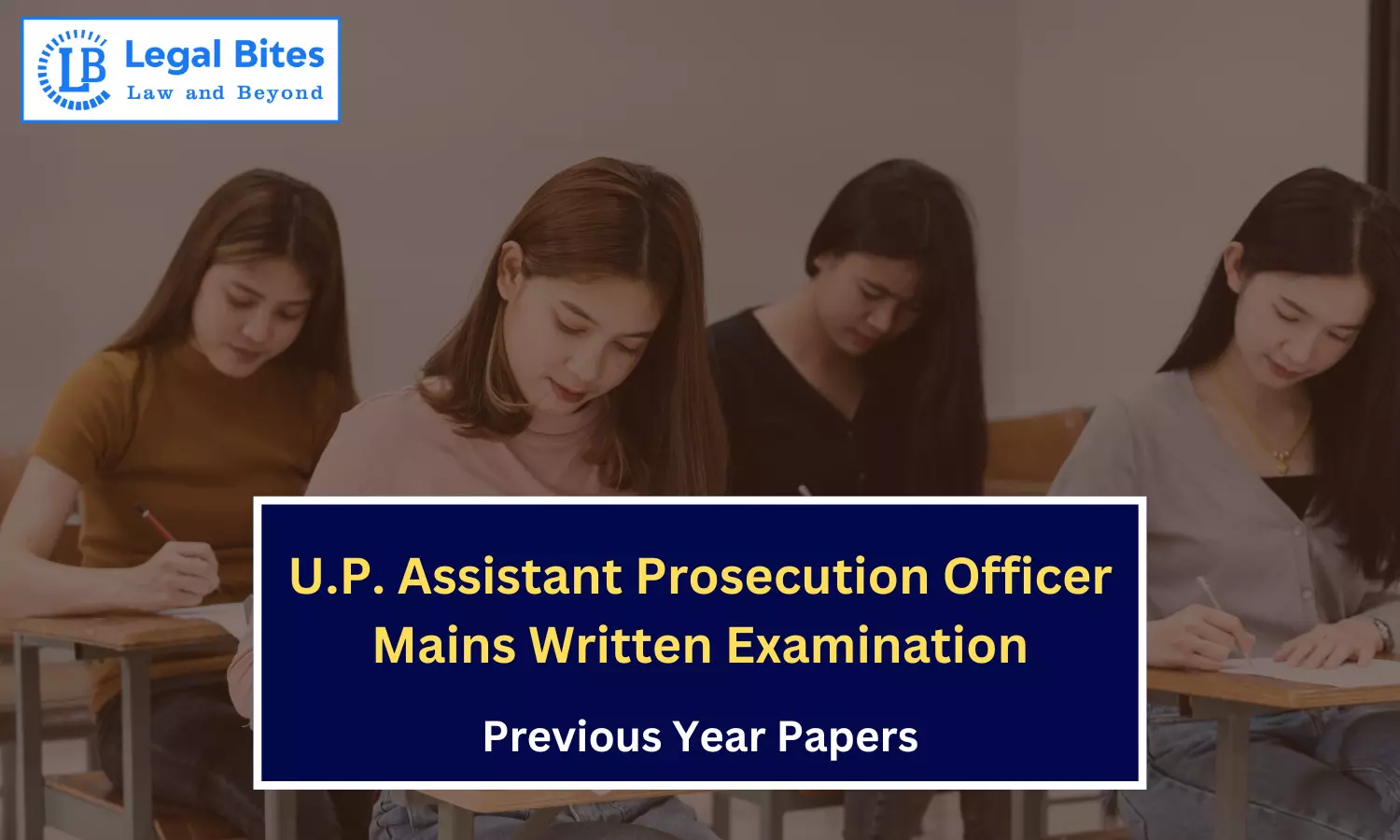U.P. Assistant Prosecution Officer Exam Mains 2022 Previous Year Paper (Law of Evidence)
Candidates preparing for the U.P. Assistant Prosecution Officer Exam should solve the U.P. Assistant Prosecution Officer Exam Mains 2022 (Law of Evidence)

Candidates preparing for the U.P. Assistant Prosecution Officer Exam should solve the U.P. Assistant Prosecution Officer Exam Mains 2022 Previous Year Paper (Law of Evidence) and other previous year question papers. This helps in understanding the syllabus, preparing the subjects effectively, and aligning preparation with the types of questions asked. All successful candidates carefully analyze the tricks and question patterns of the UP APO exam. Aspirants should adopt this approach at the start of their preparation to gain a clear understanding of the question pattern and style.
U.P. Assistant Prosecution Officer Exam Mains 2022 Previous Year Paper (Law of Evidence)
Practising authentic question papers provides a real feel of the exam. Here's the U.P. Assistant Prosecution Officer Exam Mains 2022 Paper (Law of Evidence). Practice and Prepare with our UPPSC APO Mock Test Series. | SPONSORED
U.P. Assistant Prosecution Officer Mains Written Examination 2022
(Law of Evidence)
(Law of Evidence)
Time Allowed: Three Hours
Maximum Marks: 100
Specific Instructions:
(i) Answer five questions in all, in which question no.1 is compulsory.
(ii) Marks carried by each question are indicated at its end.
Question 1
(a) "Presumptions are aids to the reasoning and argumentations which assume the truth of certain matters for the purpose of some given inquiry. They may be grounded on general experience or probability of any kind or merely on policy or convenience." Explain the statement with kinds of presumptions. (10 Marks)
(b) 'A' intentionally and falsely leads 'B' to believe that Hindustan Machine Tools (HMT) belongs to 'A' and thereby induces 'B' to buy and pay for it. The Hindustan Machine Tools afterwards becomes the property of 'A' and 'A' seeks to set aside the sale on the ground that, at the time of the sale, he had no title. Decide with reference to the principle laid down in Pickard v. Sears, (1837) 6 Ad & EL 469. (10 Marks)
Question 2
(a) Explain fully the law relating to admissibility in evidence of confession made by accused persons whilst in police custody. (10 Marks)
(b) (i) 'A' being charged with embezzlement retains 'B' an advocate to defend him. In the course of proceeding, the advocate observes that an entry has been made in 'A's account book charging 'A' with the sum said to have been embezzled, which entry was not in the book at the commencement of his employment. Can 'B' (Advocate) be protected from disclosure? (5 Marks)
(ii) 'A' is tried for the murder of 'B' by poison. Whether the fact that before the death of 'B', 'A' procured poison similar to that which was administered to 'B', is relevant or not? (5 Marks)
Question 3
(a) "Whatever relevant is not necessarily admissible but all whatever admissible is relevant." Explain. (10 Marks)
(b) (i) 'A' a witness in describing the offence asserted that 'B' said, those ruffians who a year ago took away 'Manju' have again come. Let them be off. Life, property and honour are at stake. Is this evidence admissible? (5 Marks)
(ii) In the charge of murder of 'A' where the prosecution case is that on the day of the incident, the accused altered a threat that he would finish off 'A' and then after also kill himself. Is the evidence admissible to show that the accused tried killing 'A'? (5 Marks)
Question 4
(a) (i) Necessity and importance of Law of Evidence
(ii) Distinction between Presumption of Fact and Presumption of Law
(iii) Presumption of innocence
(iv) Res-Gestae (10 Marks)
(b) Answer the following:
(i) 'A' client says to 'B' (Advocate), "I have committed forgery and I wish you to defend me". Is this communication protected from disclosure? (5 Marks)
(ii) A Judge saw a document during trial and confiscated it as a document of state. Is his action in the interest of justice? (5 Marks)
Question 5
Write short answers on any four of the following: (5*4 = 20 Marks)
(i) Conclusive Proof
(ii) Expert Opinion
(iii) An Accomplice
(iv) Hearsay Evidence
(v) Plea of Alibi
(vi) Difference between Estoppel and Res Judicata
Question 6
What is 'Dying Declaration'? How is it proved? What is the principle on which dying declarations admitted in evidence? Discuss the Principle of Law as laid down in case of Pakala Narayan Swami vs. King Emperor. (20 Marks)
Question 7
(a) Define Document. What is meant by proving a document? Distinguish between primary and secondary evidence. (10 Marks)
(b) (i) 'A' agrees to sell to 'B' for 5000 "My white horse". 'A' has two white horses. Can evidence be given to show which of the two horses was meant? (5 Marks)
(ii) 'A' is tried for the murder of 'B'. Are the facts that 'A' murdered 'C'; that 'B' knew that 'A' had murdered 'C'; that 'B' had tried to extort money from 'A' by threatening to make the knowledge public, relevant? Give reasons of your answer. (5 Marks)
Question 8
"It is a general rule that the burden of proof lies upon the party who desires the court to give judgment in his favour." State the rules of determining on whom the burden of proof will lie in suit or a proceeding. Comment and state the exception, if any. (20 Marks)

